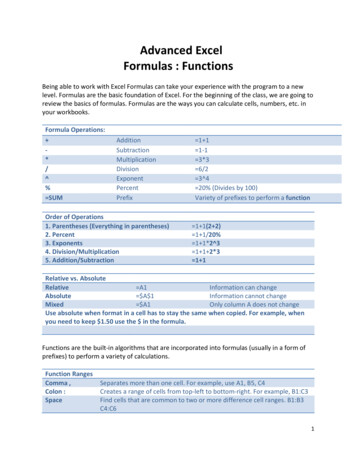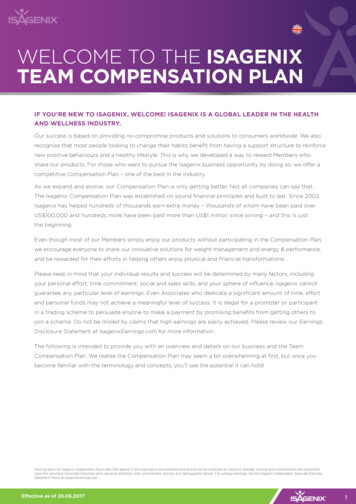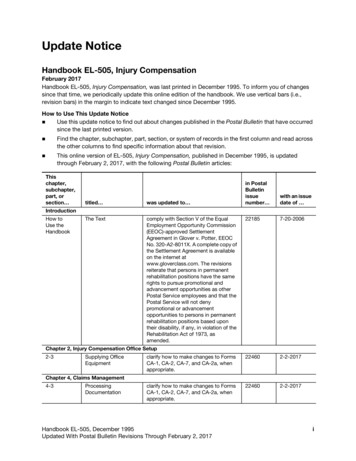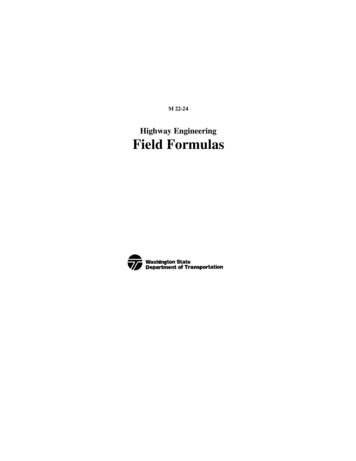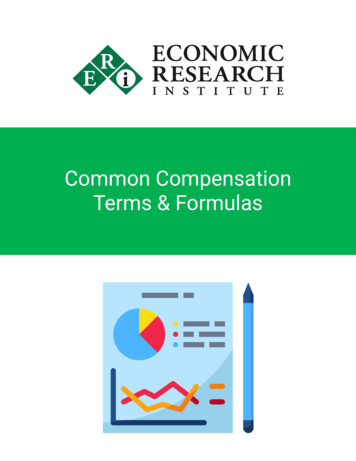
Transcription
Common CompensationTerms & Formulas
Common Compensation Terms & FormulasERI Economic Research Institute is pleased to provide the following commonly usedcompensation terms and formulas for your ongoing reference:Base Pay Short-TermIncentives(Typically 1 yearor less outlook) Total CashCompensation Long-TermIncentives(Typically 2 - 5year outlook) Total DirectCompensationAging Salary Survey DataAge your surveys by using the annual market movement of salaries to pro-rate salary surveysfrom the effective date of the survey data to the desired effective date of a salary structure.Survey Aging Factor (# Months to Age Data/12 Months) x % Annual Market Movement of SalariesExample:2% Survey Aging Factor (8 Months/12 Months) x 3% Annual Market Movement of Salaries SurveyCompa-RatioA comparison of employee pay to the salary range midpoint calculated as follows:Compa-Ratio Employee Salary / MidpointExample:0.98 78,400 Employee Salary / 80,000 MidpointIt is expressed as a decimal (e.g., 0.98).ERI Economic Research Institute I Common Compensation Terms & Formulas2
Compensation MixCompensation Mix (also known as “Pay Mix”) represents the relationship of base pay andshort-term incentives to total cash compensation. This term is commonly used in sales andexecutive compensation plan design.100% (Base Salary / Total Target Compensation) (Short-Term Incentive / Total Target Compensation)Example:40% 40,000 Base Salary / 100,000 Total Target Compensation60% 60,000 Commission / 100,000 Total Target CompensationCompensation Mix 40/60For example, a 60/40 plan will have 60% of total target compensation managed at base salaryand 40% of total target compensation managed through a short-term incentive plan (e.g.,commission).Excel Pivot Chart — Displaying an EquationDisplaying an equation and R² on an Excel pivot chart can be tricky if it is not used often.If needed, follow these instructions:1.2.3.4.5.6.7.8.Click within the pivot chartUnder Pivot Chart Tools (top of screen), click on DesignClick on Add Chart Element (left side of screen)Click on TrendlineClick on More Trendline OptionsUnder Format Trendline (right side of screen), go to Trendline OptionSelect Display Equation on ChartSelect Display R² Value on ChartFICA TaxationThe 3 tiers of the 2018 FICA taxes are described below:1.2.3.6.2% Social Security taxes on FICA wages up to the social security wage base of 128,400 for 2018 pay by both the employer and employee (12.4% in total).1.45% Medicare tax on all FICA wages paid by both the employee and employer (2.9% intotal).0.9% additional Medicare tax withholding on FICA wages greater than 200,000 in acalendar year (paid by the employee).For more information, see https://www.irs.gov/taxtopics/tc751ERI Economic Research Institute I Common Compensation Terms & Formulas3
GrandfatheringUpon implementation of a new or revised compensation plan, grandfathering will protect thecurrent compensation opportunity of existing employees when performing the same role in theorganization. Grandfathering will support in minimizing employee relations issues to contributeto a successful program implementation.Gross UpA payment, such as a one-time award, may be grossed up so that an employee will receive thefull amount even after taxes. In this instance, the company will bear the cost of the tax gross up.Gross Amount Net Amount / (1.00 — the sum of all the payroll taxes expressed as a decimal)Hours of WorkAssuming a regular, full-time equivalent at 40 hours per week, there are 173.33 work hours permonth and 2,080 work hours per year.Total Hours of WorkFormula173.33 per month (40 hours per week x 52 weeks per year) / 12 months per year2,080 per year 40 hours per week x 52 weeks per yearLinear Regression AnalysisSimple linear regression analysis shows the relationship between an independent variable suchas Pay Grade (x-axis) and a dependent variable such as Salary Range Midpoint (y-axis).Example:Midpoint (Y) ( 5,714.30 x Pay Grade (X)) 19,286 (this is the amount of the Y intercept)ERI Economic Research Institute I Common Compensation Terms & Formulas4
Market PricingMarket pricing is a job evaluation methodology that creates a job-worth hierarchy based on the“applicable market rate” for benchmark jobs in the external marketplace relevant to thebusiness.Market RatioMarket Ratio (also known as “Market Index”) is a comparison of employee pay to the market ratecalculated as follows:Employee Salary / Market Rate Market RatioIt is expressed as a decimal (e.g., 0.98).Mean (Unweighted Average)Calculates the average of what all companies pay in a salary survey for a job.Mean (Unweighted Average) sum of all numbers in a data set / # of items in a data setERI Economic Research Institute I Common Compensation Terms & Formulas5
Mean (Weighted Average)Calculates the average of what all employees are paid in a salary survey for a job.Mean (Weighted Average) ((Company 1 Pay x # of Employees in Company 1) (Company 2Pay x # of Employees in Company 2) (Company 3 Pay x # of Employees in Company 3) (Company 4 Pay x # of Employees in Company 4) (Company 5 Pay x # of Employees inCompany 5)) / Total # of Employees ReportedMedianDescribes the central tendency of the data to minimize the effect of extreme values. It is themiddle value in a set of ranked salaries and is also known as the 50th Percentile.ERI Economic Research Institute I Common Compensation Terms & Formulas6
Mileage (2018 IRS Standard Mileage Rate)Business TravelMedical Travel/Moving CostsCharitable Mileage Rate54.5 cents per mile18 cents per mile14 cents per mileFor more information, ates-for-2018-up-from-rates-for-2017ModeThe number that is reported most frequently in a data set.Example (in low to high order):2%, 3%, 3%, 3%, 3%, 3.5%, 4%, 5%3% is the mode because it is reported most frequently (4x)On Target Earning (OTE)Equivalent to total target cash compensation.Example: 100,000 OTE 70,000 Base Pay 30,000 Short-Term Incentives at TargetPercentileA percentile of a data set will have the same percentage of data falling below it (e.g., 50th, 75th,90th percentiles).To calculate a desired percentile, use the following formula:Desired Percentile (# of Data Points 1) x Desired Percentile # from the bottomPromotional BudgetsApproximately one-half of companies budget for promotions, while the other half of companiestypically do not. When promotional increases are not budgeted, they are typically paid for fromturnover, vacancies, and other compensation cost savings. A 1% budget is commonly usedwhen budgeting for promotions.ERI Economic Research Institute I Common Compensation Terms & Formulas7
QuartilesQuartiles are three values obtained by dividing the sorted dataset into four equal parts. Thelower or first quartile is the 25th percentile. The median or second quartile is the 50thpercentile. The upper or third quartile is the 75th percentile.RangeThe difference between the high and low values of a data set.Range High Value of Data Set – Low Value of Data SetExample:Data Set: 25,000, 35,000, 46,000, 50,000, 63,000, 78,000, 80,000, 94,000, 100,000Range 100,000 High Value - 25,000 Low ValueERI Economic Research Institute I Common Compensation Terms & Formulas8
Red-Circled and Green-Circled EmployeesRed-circled employees are paid above the salary range maximum. Typically, a red-circledemployee is not eligible for a salary increase until the salary range increases and exceeds therate the employee is paid. Occasionally, a modest increase or a lump sum increases may beprovided.Green-circled employees are paid below the salary range minimum. They should be brought tothe salary range minimum to ensure they are paid within the salary range.R Squared (R²)R² is the coefficient of determination. It is a percentage that indicates how well data fits into astatistical model—sometimes simply a straight or curved regression line. A high R² is typically85% to 100% and a good fit (where 100% is a perfect fit). A low R² of 70% or less indicates aless desirable fit of the data.Salary RangeA salary range represents the minimum, midpoint, and maximum rates that a business is willingto pay employees performing a job. Typically, the midpoint or control point is set to providemarket competitive, fair, and equitable salaries based on the competitive marketplace for abusiness.Salary Range (Employee Placement)ERI Economic Research Institute I Common Compensation Terms & Formulas9
Salary Range Midpoint ProgressionIt is common to see salary range midpoint progressions (the percent difference betweenmidpoints) within a salary structure as follows:Administrative/Operative: 5-10%Professional/Management: 10-15%Executive: 15-20%Example:Salary Range SpreadIt is common to see salary range spreads (the percent difference between the minimum andmaximum) within a salary structure as follows:Administrative/Operative: 40% Professional/Management: 50% Executives: 50-65% Salary Range Minimum and Maximum FormulaTo calculate the salary range minimum and maximum from the salary range spread andmidpoint (assumes a 75,000 midpoint and a 50% range spread):Salary Range Minimum Midpoint / (1 0.5 x Range Spread)60,000 75,000 / 1.25Salary Range Maximum Minimum x ( 1 Range Spread)90,000 60,000 x 1.50ERI Economic Research Institute I Common Compensation Terms & Formulas10
Salary Range OverlapTo calculate the salary range overlap:Overlap (Max. Rate of Lower Grade — Min. Rate of Higher Grade )(Max. Rate of Higher Grade — Min. Rate of Higher Grade)Here are 3 examples of salary range overlap:1st Example: 0% overlap will not work unless it is a step structure.2nd Example: 50-60% overlap is moderate. This should be the goal of a typical salarystructure.3rd Example: Shows a substantial overlap. This would occur if there are too many salarygrades or too little difference in market rates between salary grades. Payequity issues may occur when substantial range overlap occurs.Salary Range PenetrationRange Penetration (Employee Salary - Range Min.) / (Range Max. - Range Min.)80% ( 54,880 - 39,200) / ( 58,800 - 39,200)ERI Economic Research Institute I Common Compensation Terms & Formulas11
Salary Range SpreadTo calculate the salary range spread from the maximum and minimum of a salary range:Range Spread (Maximum - Minimum) / Minimum0.50 or 50% ( 90,000 - 60,000) / 60,000To calculate the salary range spread from a minimum percent and maximum percent:Range Spread ((1 Maximum Percent) / (1 - Minimum Percent)) - 10.50 or 50% (1.20 / 0.80) - 1Salary Range Spread on Either Side of MidpointTo calculate the salary range spread from the minimum to midpoint and the midpoint tomaximum:Minimum as % of Midpoint (Midpoint - Minimum) / Midpoint- 20% ( 75,000 - 60,000) / 75,000Maximum as % of Midpoint (Maximum - Midpoint) / Midpoint 20% ( 90,000 - 75,000) / 75,000Salary Structure AdjustmentA salary structure adjustment may be used in lieu of repricing an existing structure. In this case,a flat percentage (based on the market movement of salary structure adjustment projections) istypically applied to the midpoints of the existing salary structure to adjust them to the upcomingyear.In the United States, salary structure adjustments are approximately 1% below the marketmovement of base salaries.For example, let’s assume a 2% projection for salary structure adjustments:ERI Economic Research Institute I Common Compensation Terms & Formulas12
Salary Structure Design (Excel Rate Formula)The Microsoft Excel Rate Formula can be used to develop salary range midpoints by inputtingthree numbers into the formula: (1) the desired number of salary grades, (2) the desired lowestmidpoint, and (3) the desired highest midpoint. The result will calculate the following:(4) suggested midpoint percent progression.Excel Formula Rate((Number of Salary Grades-1),0,(Desired Lowest Midpoint*-1),Desired Highest Midpoint,1)Example:Salary Structure StrategiesLead the MarketA lead the market strategy will set the salary range midpoints at the defined market rate at theend of the plan year. A lead the market approach might be used by highly successful companiesin a highly competitive labor market. These companies will have the financial resources to payat a lead the market strategy.Example: 103, 750 100,000 x { 1 [3% AnnualizedMarket Movement of Salaries x (15 Months toEnd of Plan Year / 12 Months in a Year)]}DollarsLead the Market Formula Market Data x {1 [Annualized Market Movement of Salaries x (# of Months to End of PlanYear / 12 Months in a Year)]}Company3%MarketTime(Lead the Market)ERI Economic Research Institute I Common Compensation Terms & Formulas13
Lag the MarketA lag the market strategy will set the salary range midpoints at the defined market rate at thebeginning of the plan year. A lag the market approach might be used by a start-up organizationor an organization that does not have the financial resources to pay at a higher level. Trainingprograms might be offered in lieu of higher cash compensation.Example: 100, 750 100,000 x { 1 [3% AnnualizedMarket Movement of Salaries x (3 Monthsto Start of Plan Year / 12 Months in a Year)]}DollarsLag the Market Formula Market Data x {1 [Annualized Market Movement of Salaries x (# of Months to Start of PlanYear / 12 Months in a Year)]}Market3%CompanyTime(Lag the Market)Lead-Lag the MarketA lead-lag the market strategy will set the salary range midpoints at the defined market rate atthe middle of the plan year. This is the most prevalent of the market strategies. It ensures avery competitive position to the market place and will be slightly ahead of the market for sixmonths of the year and slightly below the market for six months of the year.Example: 102, 250 100,000 x { 1 [3% AnnualizedMarket Movement of Salaries x (9 Months toMiddle of Plan Year / 12 Months in a Year)]}DollarsLead-Lag the Market Formula Market Data x {1 [Annualized Market Movement of Salaries x (# of Months to Middle of PlanYear / 12 Months in a Year)]}Market1.5%Company1.5%Time(Lead-Lag the Market)ERI Economic Research Institute I Common Compensation Terms & Formulas14
Salary Structure TypesERI Economic Research Institute I Common Compensation Terms & Formulas15
Salary Survey - AnnualAn annual salary survey will typically collect and publish market data one time each year.Salary Survey - CrowdsourcedA salary survey obtained through crowdsourced data will obtain data from the masses. It maynot be as reliable as other salary surveys since the job matches and data are typically selfreported.Salary Survey - EvergreenAn evergreen salary survey collects and publishes market data throughout the year. Typically,participants will submit the data one time per year, and the data collection cycle is staggered sothat the database is refreshed throughout the year.Standard DeviationA square root of the variance. It is a measure of dispersion which indicates a relative distancebetween each data point and the mean. When data is spread further from the mean, thestandard deviation will increase.Standard ErrorIt is the standard deviation of the sampling distribution of a statistic, most commonly of themean.Weighted Survey DataSalary survey data can be weighted to place greater emphasis on the results of one survey overanother.Example:ERI Economic Research Institute I Common Compensation Terms & Formulas16
Index - Common Compensation Terms & FormulasAging Salary Survey Data, 2Broadbands, 15Budgeting – Promotional Increases, 7Coefficient of Determination, 9Compa-Ratio, 2Compensation Mix, 3Excel Pivot Chart – Displaying an Equation, 3Excel Rate Formula, 13FICA Taxation, 3Grandfathering, 4Green-Circled Employees, 9Gross Up, 4Hours of Work, 4IRS Standard Mileage Rate, 7Job Evaluation – Market Pricing, 5Lag the Market, 14Lead-Lag the Market, 14Lead the Market, 13Linear Regression Analysis, 4Market-Based Salary Structures, 15Market Pricing, 5Market Ratio, 5Maximum, 9Mean, 5Median, 6Medicare Tax, 3Mileage Rates, 7Minimum, 9Mode, 7Monthly Equivalent – Hours of Work, 4On Target Earnings, 7Percentile, 7Promotional Budgets, 7Quartiles, 8R Squared, 9Range, 8Range Spread, 10Red-Circled Employees, 9Salary Range, 9Salary Range - Employee Placement, 9Salary Range Maximum, 9Salary Range Midpoint Progression, 10Salary Range Minimum, 9Salary Range Minimum and MaximumFormula, 10Salary Range Overlap, 11Salary Range Penetration, 11Salary Range Spread, 12Salary Range Spread on Either Side ofMidpoint, 12Salary Structure Adjustment, 12Salary Structure Design, 13Salary Structure Strategies, 13Salary Structure Types, 15Social Security Taxes, 3Salary Survey – Annual, 16Salary Survey – Crowdsourced, 16Salary Survey – Evergreen, 16Social Security Rates, 3Standard Deviation, 16Standard Error, 16Step Structures, 15Traditional Graded Salary Structure, 15Unweighted Average, 5Weighted Average, 6Weighted Survey Data, 16Yearly Equivalent – Hours of Work, 4ERI Economic Research Institute I Common Compensation Terms & Formulas17
Market Ratio Market Ratio (also known as “Market Index”) is a comparison of employee pay to the market rate calculated as follows: Employee Salary / Market Rate Market Ratio It is expressed as a decimal (e.g., 0.98). Market Pricing Market pricing is a job evaluation me




